________________
K K Dixit
which 19 further strengthened on discovering that here as in those early tatakas references are made to the texts like Prajnapana and Jivabhigama But since these passage do not exhibit stylistic variations of the early salakas Prof Deleu becomes hesitant and then surmising that the references to Prahapana and Jnablagama might be a later Interpolation he gets ready to grant that the passages are a later accretion As can be seen, Prof Deleus whol. position heavily depends on the considerations related to style Thus hiding these passages to exhibit two stylistic tendencies - viz to be uniposite and to refer to other texts-h is inclined to group then with the earlier satakas while finding them to luck certain other stylistic tendencies he is inclined to treat them as a later accretion The procedure is considerably vulnerable, for decisive in this connection ought to be the considerations related to content For example, one passage in the first uddelake of the jataka 25 (p 842b) speaks of 14 types of being But these 14 being types are unkown even to a text as late as Prajñāpanā on the other hand, under the title jwasthanas' they are well known to the classical Jaina authors, particularly the Karma-specialists among them Under these circumstances it should be only natural to think that the passage in question is a later interpolation in Bhagatan Be that as it may, In order to do full justice to Prof Delen's present argumentation it must also be considered how he answers his third question which relates to the Jatakas 1-20
70
As was noted in the beginning Prof Deleu's third question is 'what the characterizing speciality of the latakas 1-20 7 By way of answering this question Prof Deleu has done two things viz
(i) To classify passages into types taking into consideration their styllatic peculiarities of which five have been pin-pointed Thus we have la all the following five types of passages
(1) Ordinary dialogues
(2) Dialogues narrating episodes (abbreviated as E)
(3) Dialogues referring to the rival views (abbreviated as A)
(4) Dialogues referring to other texts (abbreviated as R)
(5) Non-dialogue passages (abbreviated as ND)
(i) To discover the principles that were possibly fullowed while arrangging the passages into uddelakas, the uddelakas Into Jatakss, the fatakas into the total text
In connection with both a good amount of solid research work has been done Let us consider them one by one,




